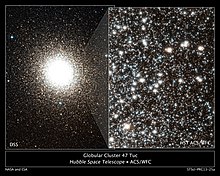47 Tucanae
| 47 Tucanae | |
|---|---|
| Apparent magnitude (V) | +4.09[3] |
| Apparent dimensions (V) | 43.8′ |
| Physical characteristics | |
| Mass | 7.00×105[6] M☉ |
| Radius | 60 ly[7] |
| VHB | 14.2 |
| Metallicity | = −0.78 Gyr[8] |
| Notable features | 2nd brightest globular cluster after Omega Centauri |
| Other designations | ξ Tuc, NGC 104, Caldwell 106, Mel 1,[3] GCl 1, 1RXS J002404.6-720456 |
47 Tucanae or 47 Tuc (also designated as NGC 104 and Caldwell 106) is a
47 Tucanae is the second brightest globular cluster after Omega Centauri, and telescopically reveals about ten thousand stars, many appearing within a small dense central core. The cluster may contain an intermediate-mass black hole.[11][12]
Early history
The cluster was recorded in 1751-2 by
In the 19th century, Benjamin Apthorp Gould assigned the Greek letter ξ (Xi) to the cluster to designate it ξ Tucanae, but this was not widely adopted and it is almost universally referred to as 47 Tucanae.[15]
Characteristics
47 Tucanae is the second brightest globular cluster in the sky (after Omega Centauri), and is noted for having a small very bright and dense core. It is one of the most massive globular clusters in the Galaxy, containing millions of stars. The cluster appears roughly the size of the full moon in the sky under ideal conditions. Though it appears adjacent to the Small Magellanic Cloud, the latter is some 60.6 ± 1.0 kpc (200,000 ± 3,300 ly) distant,[16] being over fifteen times farther than 47 Tuc.
A blue giant star with a
The core of 47 Tuc was the subject of a major survey for planets, using the Hubble Space Telescope to look for partial eclipses of stars by their planets. No planets were found, though ten to fifteen were expected based on the rate of planet discoveries around stars near the Sun. This indicates that planets are relatively rare in globular clusters.[18] A later ground-based survey in the uncrowded outer regions of the cluster also failed to detect planets when several were expected. This strongly indicates that the low metallicity of the environment, rather than the crowding, is responsible.

47 Tucanae contains at least two stellar populations of stars, of different ages or metallicities.[19] The dense core contains a number of exotic stars of scientific interest, including at least 21 blue stragglers.[20] Globular clusters efficiently sort stars by mass, with the most massive stars falling to the center.[21]
47 Tucanae contains hundreds of X-ray sources, including stars with enhanced
Possible central black hole
It is not yet clear whether 47 Tucanae hosts a central black hole. Hubble Space Telescope data constrain the mass of any possible black hole at the cluster's center to be less than approximately 1,500 solar masses.[9] However, in February, 2017, astronomers announced that a black hole of some 2,200 solar masses may be located in the cluster; the researchers detected the black hole's signature from the motions and distributions of pulsars in the cluster.[11] However, a recent analysis of an updated and more extensive timing data set on these pulsars provides no solid evidence in favor of the existence of a black hole.[12]
Modern discoveries
In December 2008,
In May 2015, the first evidence of the process of
References
- ^ "Retirement in the suburbs". Retrieved 12 June 2015.
- Bibcode:1927BHarO.849...11S.
- ^ a b c d e "NGC 104". SIMBAD. Centre de données astronomiques de Strasbourg. Retrieved 2006-11-17.
- ^ .
- S2CID 118864854.
- S2CID 118652005. Mass is from MPD on Table 1.
- ^ distance × sin( diameter_angle / 2 ) = 60 ly. radius
- ^ S2CID 51825384.
- ^ S2CID 116985213.
- ^ "47 Tuc: A Great Globular Cluster of Stars". Astronomy Picture of the Day. August 26, 2008. Retrieved 25 May 2017.
- ^ S2CID 1289123.
- ^ .
- ISBN 978-1-107-01501-2.
- ISBN 978-0-7188-9478-8.
- ISBN 978-1-107-08397-4.
- .
- S2CID 236881267.
- ^ "A Shortage of Planets". Archived from the original on 2010-08-20. Retrieved 16 November 2010.
- S2CID 18652047.
- ^ "NASA's Hubble Space Telescope Finds "Blue Straggler" Stars in the Core of a Globular Cluster". Hubble News Desk. 1991-07-24. Retrieved 5 May 2006.
- ^ Bryner, Jeanna (30 October 2006). "Mass Migration: How Stars Move in Crowd". Space.com. Retrieved 14 November 2010.
- S2CID 29975340.
- ^ "The 25 millisecond radio pulsars in 47 Tucanae".
- ^ "Pulsars in Globular Clusters". Archived from the original on 2021-03-18. Retrieved 2016-04-27.
- S2CID 13583168.
- S2CID 14022231.
- S2CID 3239801.
- ^ "The Australian Optical SETI Project" (PDF).
- ^ "Hubble Catches Stellar Exodus in Action". Space Daily. 18 May 2015.
- ^ "The Astrophysics Spectator: The Hertzsprung-Russell Diagrams of Star Clusters". www.astrophysicsspectator.org. Retrieved 2019-02-16.
External links
- 47 Tucanae at the ESA-Hubble website
- 47 Tucanae, Galactic Globular Clusters Database page
- 47 Tucanae at the Chandra X-ray Observatory website
- NGC 104
- Nemiroff, R.; Bonnell, J., eds. (7 November 1998). "Globular Cluster 47 Tucanae". Astronomy Picture of the Day. NASA.
- The Toucan's Diamond ESO

![{\displaystyle {\begin{smallmatrix}\left[{\ce {Fe}}/{\ce {H}}\right]\end{smallmatrix}}}](https://wikimedia.org/api/rest_v1/media/math/render/svg/4c0821bd80891e071c08e7c7ee8e022baedf522c)